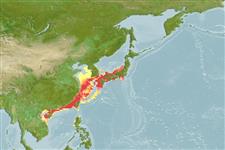Common names from other countries
>
Eupercaria/misc (Various families in series Eupercaria) >
Haemulidae (Grunts) > Plectorhinchinae
Etymology: Parapristipoma: Greek, para = the side of + Greek, pristis = saw + Greek, poma = operculum (Ref. 45335).
Environment: milieu / climate zone / depth range / distribution range
Ecología
marino bentopelágico; oceanodromo. Subtropical; 39°N - 15°N, 105°E - 140°E
Indo-West Pacific: southern Japan, East China Sea and Taiwan.
Length at first maturity / Tamaño / Peso / Age
Maturity: Lm 18.0, range 16 - 20 cm
Max length : 40.0 cm SL macho / no sexado; (Ref. 559); peso máximo publicado: 1.1 kg (Ref. 40637)
Cultured and released for fishery in Japan. The species prefers relative warm water, high salinity, and rocky shores. The species does seasonal offshore-inshore migrations in limited areas (Ref. 34104).
Oviparous, distinct pairing during breeding (Ref. 205). A couple ascends quickly to the surface and spawns (Ref. 34104).
Masuda, H., K. Amaoka, C. Araga, T. Uyeno and T. Yoshino, 1984. The fishes of the Japanese Archipelago. Vol. 1. Tokai University Press, Tokyo, Japan. 437 p. (text). (Ref. 559)
IUCN Red List Status (Ref. 130435)
CITES (Ref. 128078)
Not Evaluated
Threat to humans
Harmless
Human uses
Pesquerías: comercial
Más información
ReferenciasAcuiculturaPerfil de acuiculturaRazasGenéticaElectrophoresesheritabilidadEnfermedadesProcesamientoMass conversion
ColaboradoresImágenesStamps, Coins Misc.SonidosCiguateraVelocidadTipo de nataciónSuperficie branquialOtolitosCerebrosVisión
Herramientas
Special reports
Download XML
Fuentes de Internet
Estimates based on models
Preferred temperature (Ref.
115969): 18.2 - 26.6, mean 24.1 (based on 168 cells).
Phylogenetic diversity index (Ref.
82804): PD
50 = 0.5625 [Uniqueness, from 0.5 = low to 2.0 = high].
Bayesian length-weight: a=0.00933 (0.00555 - 0.01568), b=3.01 (2.86 - 3.16), in cm Total Length, based on LWR estimates for this species & (Sub)family-body (Ref.
93245).
Nivel trófico (Ref.
69278): 3.4 ±0.45 se; based on food items.
Resiliencia (Ref.
120179): Medio, población duplicada en un tiempo mínimo de 1.4-4.4 años (K=0.25-0.35; tm=2; Fec=30,083).
Fishing Vulnerability (Ref.
59153): Moderate vulnerability (36 of 100).
